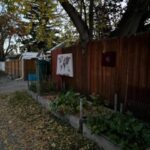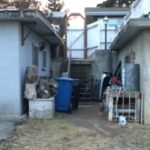Week 4/5: A connection between toilets in Tema, Ghana, and back alleys in western Canada?
In a previous blog I mentioned sharing some reflections on an article from the “Built Infrastructure” list about toilets in Tema, Ghana.
 A dog walk on day two of our Exclusion and Inequality intensive had me thinking of what happened to the community around public toilets in this article: Public things, excremental politics, and the infrastructure of bare life in Ghana’s city of Tema ) and my experiences in the back alleys of my own neighbourhood.
A dog walk on day two of our Exclusion and Inequality intensive had me thinking of what happened to the community around public toilets in this article: Public things, excremental politics, and the infrastructure of bare life in Ghana’s city of Tema ) and my experiences in the back alleys of my own neighbourhood.
A very brief recap of this fascinating paper (although you should read it – totally worth it!) – it describes how social, economic, gender and class structures intersected at the local toilet facility. Initially, these public toilets were constructed by the government and looked after by them, free for anyone to use. Community members from all classes intermingled in the public toilets, which sometimes lead to conflict. The resettled community nearby grew in number, and government did not continue to address their needs, likely because of the lower socio-economic class of the people there. Eventually the toilets were no longer maintained as a public good by the government, so the people took over management of the toilets. From the people who held power (ie the keys to the bathroom) to providing a place for political discussion, and even a way to earn a livelihood for others (market stalls set up outside the facility), the toilets were a hub of the community where people came to meet and collaborate. The public toilets and the activity that sprung up around them changed the societal dynamics of that community.
intermingled in the public toilets, which sometimes lead to conflict. The resettled community nearby grew in number, and government did not continue to address their needs, likely because of the lower socio-economic class of the people there. Eventually the toilets were no longer maintained as a public good by the government, so the people took over management of the toilets. From the people who held power (ie the keys to the bathroom) to providing a place for political discussion, and even a way to earn a livelihood for others (market stalls set up outside the facility), the toilets were a hub of the community where people came to meet and collaborate. The public toilets and the activity that sprung up around them changed the societal dynamics of that community.
 Now, you may ask, how does this relate to where I live? I would like to note that I am not attempting to equate the resettlement of Tema residents with my own privileged life, but I do see a theme related to public infrastructure that goes beyond its intended use to impact a society.
Now, you may ask, how does this relate to where I live? I would like to note that I am not attempting to equate the resettlement of Tema residents with my own privileged life, but I do see a theme related to public infrastructure that goes beyond its intended use to impact a society.
I live in an older neighbourhood in my city. It is a bit isolated from other parts of the city. It’s mostly middle class and not very diverse but it’s changing gradually as older adults finally sell their houses. 
What do you think of when I mention back alleys? As far as the prairies of western Canada goes, it’s a lane behind your property, a place where you keep your garbage, recycling, and compost bins. Many people use the alley to park derelict vehicles, and most are unpaved. Instead, they are graveled and full of bumps and potholes. In the hot summer, the pungent smell of the garbage bins prevails. In the downtown core, unhoused people sometimes sleep near the bins or other places in the alleys to avoid being picked up by police. There are many people who think back alleys are dark and dangerous places.

Wilf Perrault – Alley Prism – 2017 – from Noveau Gallery https://nouveaugallery.com/artwork/alley-prism/.
Ever since I was a child I spent a lot of time wandering in back alleys. In many small cities and towns on the prairies in Canada back alleys were prevalent. In addition to garbage collection, it was where you parked your car in the garage off the alley, where the kids roamed around and played instead of the busy street, and from where you could raid gardens and take a peek into other people’s lives. At my high school we had an artist in residence, Wilf Perrault, who created beautiful paintings of back alleys. In my travels, I sometimes found my adventures taking me down alleys – I recall hearing the clatter of Mah Jong tiles when rushing down an alley at night in Tsim Sha Tsui.
These days I usually walk in the alley to stay away from the vehicle traffic on the streets. It is quieter, so my dog is a bit calmer and she is also not doing her business on someone’s front lawn.
Here are some interesting events that have occurred in the back alleys of my neighbourhood: I have encountered people who are digging through recycling bins to pick out cans and bottles that can be turned in for cash and have chatted with these people to learn their stories and in a few cases, help them out of a jam. I have introduced myself to new neighbours, started a conversation, and ended up learning some parenting tips, as well as discovering shared political views. I have been able to give away items I no longer need to the benefit of others and been able to pick up items for free that I needed, avoiding the landfill – even a broken bicycle we were able to fix and use! I have enjoyed time with my daughter when she was growing up, pulling her on the sled in winter and collecting people’s discarded Christmas trees to cut up for firewood. I have encountered people looking for their lost pets, and even rescued two lost dogs and an injured merlin. I have made deals to sell used tires to a man I saw working on his vehicle in the alley. There are even a few houses with artwork hanging on their fence that provide an alley aesthetic.
in winter and collecting people’s discarded Christmas trees to cut up for firewood. I have encountered people looking for their lost pets, and even rescued two lost dogs and an injured merlin. I have made deals to sell used tires to a man I saw working on his vehicle in the alley. There are even a few houses with artwork hanging on their fence that provide an alley aesthetic.
 In the winter, our alleys are not cleared, and people’s cars get stuck. We push each other out of snowbanks and work together to shovel large swaths ourselves. In the spring, when the snow melts, I go for bike rides to splash through the mud puddles.
In the winter, our alleys are not cleared, and people’s cars get stuck. We push each other out of snowbanks and work together to shovel large swaths ourselves. In the spring, when the snow melts, I go for bike rides to splash through the mud puddles.
I have made friends who I see regularly walking their dogs in the alley or tinkering in their garden or garage. I have been asked about my Every Child Matters orange shirt and was able to share information with this man about residential schools (which he had never heard of). I have picked pears, apples, and berries to eat from the branches of shrubs and trees hanging over into the alley. I have seen beauty and I have seen dead animal carcasses. I regularly encounter my next door neighbours in the alley and it turns into a place of social connection.
Alleys were created by the city as a place for the garbage, a place to hide unsightly things. Personally, I have found utility, friends, political dialogue, economic benefits, connection, and a place that brings me some joy, even if it’s sometimes a little smelly. Not unlike what the people of Tema may have discovered in their public toilets.
(Photographs by Darcie Harding, taken between 2020 – 2022)
(Darcie Harding, 2022)




Thank you for sharing your story about the alley. It is so warm and moving, and I really enjoyed reading it. It makes me want to travel to Canada and see those scenes with my own eyes. I hope I can do that some day in the future with my partner.
If you ever make it to Calgary, please come visit!
YES!!! (Hahaha-so excited that you went all in on the Tema toilet article–it remains one of my favorites to cite because there was no way the city planners in Tema could have planned for how the community would ultimately reap the most benefit out of the toilets).
And I like the alley comparison. I guess people are prone to reengineering systems to suit their situations if they can find a way to do so relatively easily. This seems harder for people to do in digital systems for some reason. Maybe because everything has to be built digitally (meaning an engineer needs to have already thought about what tools you will need to use their system) as opposed to when something is built out in the real world where it’s much easier to grab outside elements and introduce them into the fixture (plants or artwork in an alley for example)? There was a chapter in a novel I read recently (A Visit from the Good Squad by Jennifer Egan) in which a teenager keeps a PPT diary (the chapter is an excerpt from this diary, so it’s basically all a recreation of slides with brief words and charts), which was fun and refreshing because it broke the established rules of the book (up to that point, the storyline was exclusively made up of words) and also socially accepted conventions about what we use PowerPoint for. But these niche adaptations don’t seem to lend themselves to scalability in the ways we’ve grown to expect from our online infrastructure. Easy-to-onboard Facebook, with its highly restricted and controlled structure, beat out customizable Myspace. So I don’t know what to make of that? Maybe there should be a locavore movement for platforms? Everywhere gets to grow its own solution with a universal API so these solutions can connect with each other while maintaining the uniqueness that allows them to best serve the wishes of their users?
Yes you could say it may have surprised the sh!t out of them… (IYKYK – if you read the article).
It’s funny how humans adapt things to suit their needs – I see this often in city pathways that are not built where the user wants them, you can see worn areas of grass where people took the route they wanted to follow which is not where the sidewalk or pathway was placed. This is also true digitally in my experience – people will find a way around intended paths/processes or get frustrated and quit which is why designing with users (UX Design) is so important. In the digital world I work in, a UX Designer will translate user needs for developers – so they tell them what they need and why, but not how to build it – the developers will figure out how. Developers make it work for the entire system to function using code and may have different user interfaces depending on the audience. It’s so interesting to think of the motivations behind user preferences too – and why they do things in a certain way and might avoid other things. UX research not only identifies pain points but goals and motivations of users – its very interesting!
I loved this read Darcie- and in general your ability to take raw information from the world around you, ponder on it and contextualise! Your reflection on the dark alleys, took me back to a course I engaged with during my Bachelor’s degree on Regional and Urban Economics. We looked at why firms cluster in similar locations, how they choose their locations etc. in quite a bit of detail and the implications of this (both social and economic). One of the discussions we had was about how the local embededness of social capital (a broad and generalised definition being the stock of relational resources of communities and societies) changes depending on the level of formality in the institutions that support pockets of society, and the impact this has on lowering transaction costs that underly the structure for transfer and sharing of knowledge/information